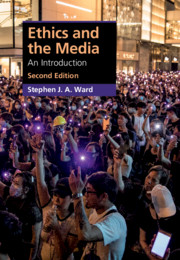Book contents
- Ethics and the Media Second Edition
- Cambridge Applied Ethics
- Ethics and the Media
- Copyright page
- Dedication
- Contents
- Introduction: Media Ethics in a Global Age
- 1 Doing Media Ethics
- 2 Reconstructing Media Ethics
- 3 Media, Engagement, and Democracy
- 4 Truth, Objectivity, and Fake News
- 5 Media Harm
- 6 Media and Extremism
- 7 Citizens, Media, and Macro-resistance
- 8 Global Media Ethics
- Bibliography
- Index
5 - Media Harm
Published online by Cambridge University Press: 22 October 2020
- Ethics and the Media Second Edition
- Cambridge Applied Ethics
- Ethics and the Media
- Copyright page
- Dedication
- Contents
- Introduction: Media Ethics in a Global Age
- 1 Doing Media Ethics
- 2 Reconstructing Media Ethics
- 3 Media, Engagement, and Democracy
- 4 Truth, Objectivity, and Fake News
- 5 Media Harm
- 6 Media and Extremism
- 7 Citizens, Media, and Macro-resistance
- 8 Global Media Ethics
- Bibliography
- Index
Summary
The discussion of democratic journalism focused on what I called the pro-active norms of journalism – norms that call on journalists to promote certain ideals and social goals.
However, I also said that media ethics contains “restraining” norms that call on journalists to act responsibly when they use their freedom to publish. The power of news media can be abused. Abuse leads to misinformation, erroneous judgments, and harmful consequences for individuals, groups, and countries. Therefore, we can ask: What are the main restraining principles of democratically engaged journalism? One set of principles has to do with avoiding or minimizing media harm, that is, the harm that is caused by publication.
Keywords
- Type
- Chapter
- Information
- Ethics and the MediaAn Introduction, pp. 127 - 156Publisher: Cambridge University PressPrint publication year: 2020

